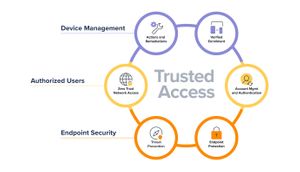Navigating the complex world of IT security: how unified security simplifies protection
Securing your organization is a difficult task. Choosing the right software solutions can help. Learn how a unified security platform makes security easier.
So you’ve been tasked with the complicated responsibility of defending your organization’s cybersecurity. Finding security while wrestling with budget constraints, the sea of possible software solutions and leadership approval all while attackers are making their moves is not for the faint of heart.
There are ways to make this process easier for you. One way is to choose a unified security platform that’s built to work together with as little headache as possible. In this blog, we’ll talk through what unified security means and how this makes security easier.
Features of a unified security platform
A unified security solution has to be thorough. It must address how to:
- Detect and remediate threats
- Grant access to company resources and data
- Enforce security policies
- Keep devices healthy and up to date
- Secure users and company data
This usually requires a few different types of software: device management, identity and access management, and endpoint security. While you can use piecemeal solutions to achieve these features, a unified platform means each software can seamlessly communicate with the other, taking your capabilities beyond the sum of each solution. Let’s talk a bit more about the advanced security protections unlocked by integrating software solutions.
Account provisioning and access
Let’s start with user accounts. How do you securely assign users to devices and to applications? And how do you determine how these can be accessed?
Your mobile device management (MDM) solution is a great place to start. With MDM and a cloud identity provider (IdP), you can:
- Create user accounts on devices
- Deploy approved apps to devices or offer them in a Self Service portal
- Keep apps and operating systems up to date
- Enforce password and other security policies
An MDM integrated with your identity and access software helps you go one step further by:
- Keeping your device and app passwords in sync with single sign-on (SSO)
- Determining access with context-aware policies that verify device health and user identity
- Offering Zero Trust Network Access (ZTNA) for secure connections to business apps
In other words, your MDM deploys and maintains the software your users need to do their work, while your identity and access software makes sure their apps are being securely accessed. The magic happens when your MDM and identity software talk to each other, giving users a convenient and secure sign on experience.
Incident response automation
Device compliance is a tricky and transient state to achieve. By itself, endpoint security software can only tell you when a device is out of compliance. But if it talks to your MDM and identity/access software, your platform can get the device back into compliance or prepare it for remediation.
Let’s say a user accidentally downloaded malware. What does your unified security platform do?
- Your endpoint security detects the threat.
- Your MDM software uses this as a trigger to automatically launch a predefined remediation policy.
- Your identity and access software isolates the device from the network.
- The user is notified of the threat on their device and the remediation workflow begins, removing the malware from their system.
This is a workflow you need to be able to rely on. When your software is built to work together this process is seamlessly automated, responding to threats in near real time. This simply can’t be achieved if these systems don’t work together or if any manual intervention from IT is required.
Save time and money
Beyond being more capable than standalone solutions, a unified security platform can give you a better return on investment (ROI). If you consider:
- A unified platform’s automations keep IT more efficient.
- Any platform support required comes from a single expert vendor.
- Automations are simpler for the user too, especially when they explain what’s happening to their device. An easier user experience can mean fewer IT support tickets.
Consider using a platform that’s built specifically for the operating systems you’d like to manage and secure. This can improve your long-term ROI even more.
Take a deep dive into how an integrated security solution is best for your organization.


